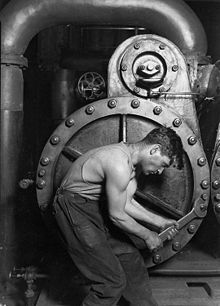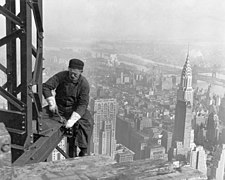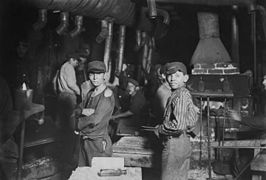Lewis Hine
Lewis Wickes Hine (born September 26, 1874 in Oshkosh , Wisconsin , † November 3, 1940 in New York ) was a teacher, sociologist and social documentary photographer .
Live and act
Lewis Wickes Hine grew up in a simple restaurant in Oshkosh, Wisconsin, in the northeastern United States. In 1892 his father died in an accident or by suicide. As early as 1890, after finishing grammar school and leaving his father's business, Hine began to work. He initially earned his living with changing and poorly paid jobs, which probably made him aware of social issues.
From 1900 to 1905 Hine studied education in Chicago and New York. In 1907 he enrolled at Columbia University in New York again for sociology. Parallel to his studies he worked from 1901 to 1908 as a teacher (" teaching elementary science ") at the Ethical Culture School founded by Felix Adler in New York. During this training and employment he was promoted by the educator Frank Addison Manny (1868-1954), who headed the State Normal School in Oshkosh from 1898 to 1900 and, from 1901, the Ethical Culture School in New York for six years. 1896-1897 Manny was an assistant to the philosopher and educational theorist John Dewey , who in turn also studied with Hine (inter alia).
Hine saw photography as a political means to expose grievances, but also as a cultural medium with which the dignity of the people could be attested. In terms of photo technology, he was self-taught and did not acquire the relevant knowledge until around 1903. Since 1904, at Manny's suggestion, he has been documenting school operations at the Ethical Culture School (where many Eastern European and Jewish immigrants were taught) and at this time also began to take photographs at the New York immigration station Ellis Island . Since 1906 he has been systematically documenting child labor in the USA for the National Child Labor Committee (NCLC), headed by the school founder Felix Adler . In 1908 he left school and worked full time for the NCLC. The aim of the NCLC was to raise public awareness of child labor and to encourage the government to create a national child protection law. Mainly because of this investigative work for the NCLC, Hine is generally regarded as an outstanding representative of social documentary photography. In addition, he also took photographs on other topics for the sociological magazines Charities and The Commons or (as a successor) The Survey and Survey Graphic , which were his most important clients and in which his reports were regularly printed from 1907 to 1939. Important contacts here were the brothers Arthur P. Kellogg (1878-1934) and Paul Underwood Kellogg (1879-1958), whom he had already met in 1904, who worked there.
In 1918, Hine resigned from NCLC and worked temporarily in Europe as a photographer for the American Red Cross. After his return to the USA in 1919, he changed his concept: he broke away from accusatory photography as he had practiced on behalf of the NCLC and instead tried to highlight the positive value of work with his so-called “work portraits” Show people. He called this type of social documentation " Interpretive Photography ". Instead of industry-critical organizations like the NCLC, Hine had decided to win the industry itself as a customer - or as a sponsor for its own photographic project. He was quite successful with this: For example, he photographed from 1923 to 1927 for the employee magazine Western Electric News of the Hawthorne Works, Western Electric , Chicago. And in 1924 he was honored with a prize from the Art Directors Club at the Exhibition of Advertising Art in New York .
In 1930 Hine was commissioned to photograph the construction of the Empire State Building . Together with his son Corydon, at the age of 56, he made over 1,000 recordings. The project lasted half a year. In 1932 Hine published the illustrated book Men At Work , in which he expressed his fascination for the human control of nature with the help of technology.
Despite all this recognition, Hine had increasingly financial difficulties since the economic crisis of 1929 and he received fewer and fewer orders. In particular, he failed to get a job with the Farm Security Administration , for which he could have worked well as an experienced documentary photographer. In contrast, he was now perceived in artistic circles. In early 1938 he was able to introduce himself to the curator Beaumont Newhall of the Museum of Modern Art in New York. Newhall bought his work for the museum, selected some of Hine's photographs for an exhibition in Paris and wrote the articles Documentary Approach to Photography (1938) and Lewis Hine (1938), in which Hine was recognized as a documentary photographer. This, in turn, drew the attention of critic Elizabeth McCauslaund to Hine. She and her photographer friend Berenice Abbott contacted him, wrote the article Portrait of a Photographer (1938) for Survey Graphic and organized a retrospective of his work, which was shown in New York's Riverside Museum in 1939 . Abbott also introduced Hine to the Photo League , where he was soon seen as a great role model. But even this did not change anything about Hine's material situation. From 1937 to 1940 he applied several times, unsuccessfully, for a scholarship from the Carnegie Corporation and the Guggenheim Foundation for a project on traditional crafts. In October 1940 he submitted another application to the Guggenheim Foundation for a project on immigration: he wanted to combine his old recordings of Ellis Island with a documentary about the current life of those who immigrated to the United States at the time.
Lewis Hine died on November 3, 1940 as a result of an operation. His son Corydon donated Hine's private archive to the Photo League. Initially, founding member Sid Grossman stored it at home. After the Photo League closed in 1951, it was temporarily kept by Walter Rosenblum , who had also been a member there. The collection was apparently offered to the Museum of Modern Art in New York, but the director of the photography department there, Edward Steichen (successor to Newhall since 1947), rejected it. Eventually she took over Newhall in 1955 for the George Eastman House in Rochester, NY (where he had worked since 1948). During Hine's lifetime, the Russell Sage Foundation and the New York Public Library had archived works by Hine. The Library of Congress also received the NCLC's collection of Hines photographs in 1954. Photographs taken by Hine for the American Red Cross are also archived there. There are also the digitally accessible collections of the Albin O. Kuhn Library & Gallery ( University of Maryland, Baltimore County ) and the National Archives and Records Administration .
Child labor at a glass factory in Indiana , 1908
literature
- Bezner, Lili Corbus: Photography and Politics in America. From the New Deal into the Cold War. Baltimore, Maryland (The Johns Hopkins University Press), 1999, ISBN 0-8018-6187-X .
- Blumenthal, Ralph: Shadows Cast by Forgery. The FBI Investigates Complaints About Lewis Hines Prints. New York Times, August 16, 2001 ( www.nytimes.com ).
- Gutman, Judith Mara: Lewis W. Hine and the American Social Conscience. New York (Walker and Company), 1967.
- Hine, Lewis W .: Men At Work. Photographic Studies Of Modern Men And Machines . Dover Publications, New York 1977, ISBN 0-486-23475-4 . (Original edition 1932)
- Kaplan, Daile: Lewis Hine in Europe. The Lost Photographs . Abbeville Press Publishers, New York 1988, ISBN 0-89659-745-8 .
- Kaplan, Daile (Ed.): Photo Story. Selected Letters and Photographs of Lewis W. Hine . Smithsonian Institution Press, Washington and London 1992, ISBN 1-56098-169-5 .
- McCausland, Berenice (text) / Abbott, Berenice (photo): Portrait of a Photographer. In: Survey Graphic. October 1938, pp. 502-503 ( Survey Graphic. Vol. XXVII (1938) at archive.org ).
- McCausland, Berenice: Hine's Photo Documents. In: Photo Notes. September 1940. Source: McCausland Papers , Lewis Hine: Notes and Research Material 1938-1942, Box 22, Folder 19 (Nos. 13-16) ( www.aaa.si.edu ).
- Newhall, Beaumont: Documentary Approach to Photography. In: Parnassus. Vol. 10, No. 3 (March 1938), pp. 2-6 ( www.jstor.org ).
- Newhall, Beaumont: Lewis Hine. In: Magazine of Art. Vol. 31, No. 11 (November 1938), pp. 636-637.
- Panzer, Mary: Lewis Hine. Phaidon Verlag (series: Phaidon 55), Berlin 2002, ISBN 0-7148-9321-8 .
- Rosenblum, Walter et al .: America & Lewis Hine. Photographs 1904-1940 . Aperture, New York 1977, ISBN 0-89381-017-7 .
- Sampsell-Willmann, Kate: Lewis Hine as Social Critic . University Press of Mississippi, Jackson 2009, ISBN 978-1-60473-368-6 .
- Sarin, Bernhard: Lewis Hine revisited. The anthropological approach of Lewis Hines Work Portraits. BoD - Books on Demand, Norderstedt 2019 (extended version of the certificate thesis Lewis Hine , Bildjournalismus, FH Magdeburg-Stendal 2013), ISBN 978-3-7494-5041-1 .
- Seixas, Peter: Lewis Hine. From ›Social‹ to ›Interpretive‹ Photographer. In: American Quarterly. Vol. 39, No. 3 (Fall 1987), pp. 381-409 ( www.jstor.org ).
- Steinorth, Karl (Ed.): Lewis Hine. The camera as a witness - photographs 1905–1937. Edition Stemmle, Kilchberg-Zürich 1996, ISBN 3-908162-55-6 .
- Tucker, Anne Wilkes et al .: This was the Photo League. Chicago (Stephen Daiter Gallery), 2001 (without ISBN).
- Walther, Peter: Lewis W. Hine. America at Work. Taschen, Cologne 2018, ISBN 978-3-8365-7234-7 .
Web links
- Lewis Hine in the Library of Congress
- Lewis Hine at George Eastman House (multiple entries under Lewis Wickes Hine)
- Lewis Hine in the New York Public Library
- Lewis Hine in the National Archives and Records Administration
- McCausland Papers , Section 7.2: Lewis Hine, 1938-1942 , online at Archives of American Art , aaa.si.edu
- Literature by and about Lewis Hine in the catalog of the German National Library
- Works by and about Lewis Hine in the German Digital Library
- Search for Lewis Hine in the SPK digital portal of the Prussian Cultural Heritage Foundation
- Lewis Hine at artfacts.net
- Lewis Hine at photography-now.com
- Lewis Hine in the catalog of the Art Library in Cologne
- Lewis Hine in the database of Find a Grave (English)
- Lewis Hine in Artcyclopedia
- Lewis Hine - Photography to change. Exhibition in the Fotomuseum Winterthur , June to August 2013
Individual evidence
- ↑ Rosenblum et al .: America & Lewis Hine. P. 16.
- ↑ Sampsell-Willmann: Lewis Hine as Social Critic. P. 76.
- ^ Hine: Biographical Notes (1940), in Kaplan: Photo Story. P. 177.
- ^ Hine: Biographical Notes (1940), in Kaplan: Photo Story. P. 178; Rosenblum et al .: America & Lewis Hine. P. 17f.
- ^ Hine: Biographical Notes (1940), in Kaplan: Photo Story. P. 177f; Bentley Historical Library, Frank Manny Papers , Biography (English)
- ↑ Chaplain: Lewis Hine in Europe. Pp. 16f, 39ff.
- ↑ Rosenblum et al .: America & Lewis Hine. Bibliography, pp. 138ff.
- ^ Kaplan: Photo Story. S. xxv.
- ↑ Chaplain: Lewis Hine in Europe. P. 59ff.
- ^ Kaplan: Photo Story. P. 19.
- ^ Letter from Hine to Paul Kellogg (July 7, 1921), in Kaplan: Photo Story. P. 20.
- ↑ Seixas: Lewis Hine. From ›Social‹ to ›Interpretive‹ Photographer. In: American Quarterly. Vol. 39, No. 3 (autumn 1987), p. 400.
- ^ Letter from Hine to Paul Kellogg (April 8, 1924), in Kaplan: Photo Story. P. 29.
- ↑ Panzer: Lewis Hine. Pp. 15, 127.
- ^ Letter from Hine to Paul Kellogg (February 19, 1938), in Kaplan: Photo Story. P. 107f.
- ↑ Interview Kaplan with Abbott (June 1990), Foreword in Kaplan: Photo Story. S. xiiif; Bezner: Photography and Politics in America. P. 78: "the league's hallowed spiritual leader, Lewis Hine"; Tucker et al .: This was the Photo League. P. 160: "Along with Paul Strand , Hine was especially revered by the Photo League, and his work served as a model for the kind of socially committed documentary photography they hoped to produce."
- ^ Correspondence in Kaplan: Photo Story. passim.
- ^ Hine: Plans for Work (October 1940), in Kaplan: Photo Story. Pp. 174-176.
- ^ Obituary in the New York Times of November 4, 1940: "Hastings, NY, Nov. 3 - Lewis W. Hine [...], died today in the Dobbs Ferry Hospital after an operation." Source: McCausland Papers , Lewis Hine: Manuscripts and Published Articles 1938, Box 22, Folder 18 (No. 11) ( www.aaa.si.edu ). Likewise, in Survey Graphic , December 1940, November 3 is given as the date of death (obituary notice Lewis W. Hine , p. 622). Many more recent publications, however, state November 4th.
- ^ Tucker et al .: This was the Photo League. P. 16.
- ^ Bezner: Photography and Politics in America. P. 234 (note 8); Blumenthal: Shadows Cast by Forgery. New York Times, August 16, 2001.
- ^ Letter from Hine to Paul Kellogg (February 19, 1938), in Kaplan: Photo Story. P. 107f; McCausland: Hine's Photo Documents ( Photo Notes. September 1940).
| personal data | |
|---|---|
| SURNAME | Hine, Lewis |
| ALTERNATIVE NAMES | Hine, Lewis Wickes (full name) |
| BRIEF DESCRIPTION | Drawing teacher, social worker and photographer |
| DATE OF BIRTH | September 26, 1874 |
| PLACE OF BIRTH | Oshkosh (Wisconsin) , USA |
| DATE OF DEATH | November 3, 1940 |
| Place of death | New York (State) |





